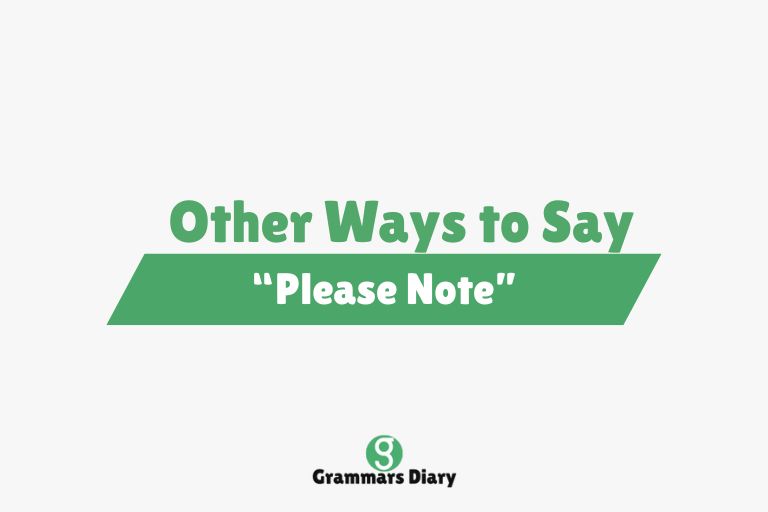“Please note” is a commonly used phrase intended to draw someone’s attention to important information, instructions, or changes. Whether in emails, documents, presentations, or academic writing, this phrase acts as a polite alert, signaling that the following information is essential and should not be overlooked.
However, relying on the same phrase repeatedly can make your writing feel monotonous or overly formal. That’s why exploring alternatives allows for a more engaging, tone-appropriate, and context-sensitive form of communication.
In this post, we’ll explore 30 alternative ways to say “please note,” along with their meanings, examples, and usage notes. These variations can help you communicate clearly while adding variety and subtle nuance to your messages.
Other Ways to Say “Please Note”
1. Kindly note
Example: “Kindly note that the meeting time has changed to 3 PM.”
Meaning: A polite variation of “please note” that maintains a formal yet courteous tone.
Usage: Often used in professional emails and notices when maintaining politeness is important.
2. Be advised
Example: “Be advised that parking will be limited during the event.”
Meaning: Alerts the reader to upcoming or important information, often used in formal contexts.
Usage: Suitable for official announcements, HR updates, or legal communications.
3. Take note
Example: “Take note of the deadline extension for the final project submission.”
Meaning: A directive phrase prompting the reader to mentally mark or remember something.
Usage: Works well in both formal and semi-formal contexts, such as memos or bulletins.
4. Bear in mind
Example: “Bear in mind that this offer is only valid for a limited time.”
Meaning: Encourages the reader to remember the information when making decisions.
Usage: Often used in advisory or persuasive writing.
5. It’s important to note
Example: “It’s important to note that late submissions will not be accepted.”
Meaning: Adds emphasis to key information, underscoring its relevance or impact.
Usage: Suitable for academic writing, policy documents, and formal instructions.
6. For your information
Example: “For your information, the office will be closed next Friday.”
Meaning: Shares useful or necessary information in a factual and non-urgent way.
Usage: Best for neutral, informative updates in emails or newsletters.
7. Just a heads-up
Example: “Just a heads-up, the system will be down for maintenance tonight.”
Meaning: Offers a casual, preemptive alert about something that might affect the reader.
Usage: Suitable for informal work settings, team messages, or peer communication.
8. Keep in mind
Example: “Keep in mind that your password expires every 90 days.”
Meaning: A reminder that encourages ongoing awareness of a particular point.
Usage: Works well in both informal and semi-formal contexts.
9. Please be aware
Example: “Please be aware that your subscription will renew automatically.”
Meaning: A gentle way of making the reader conscious of something relevant.
Usage: Common in customer support, billing notifications, and user agreements.
10. Attention
Example: “Attention: The elevator will be out of service tomorrow.”
Meaning: A strong, direct cue indicating that immediate focus is required.
Usage: Often used in signage or alerts when visibility and urgency are key.
11. You should know
Example: “You should know that this product is currently backordered.”
Meaning: Informs the reader about a piece of potentially impactful information.
Usage: Best for customer service or peer-to-peer communications.
12. Worth noting
Example: “It’s worth noting that these figures only include domestic sales.”
Meaning: Suggests that a detail is especially significant or valuable to remember.
Usage: Suitable for reports, analyses, or discussions.
13. A quick note
Example: “A quick note: the files have been moved to a new folder.”
Meaning: Indicates a brief yet important update or piece of information.
Usage: Useful in casual or internal communication.
14. Just so you know
Example: “Just so you know, the schedule has been revised.”
Meaning: Provides an informal heads-up or clarification.
Usage: Works best in relaxed or friendly tone settings, such as team chats.
15. Mark this
Example: “Mark this: submissions after the deadline will not be graded.”
Meaning: A slightly dramatic or literary way to draw firm attention.
Usage: Rarely used, but adds flair in creative or motivational writing.
16. Important to remember
Example: “It’s important to remember that these figures are preliminary.”
Meaning: Highlights that a specific piece of information should be kept in mind for future consideration or analysis.
Usage: Ideal for professional reports, presentations, or instructional material.
17. Please keep in mind
Example: “Please keep in mind that this process may take up to five business days.”
Meaning: A gentle request for the reader to retain a specific detail or expectation.
Usage: Suitable for customer-facing communication or onboarding emails.
18. Make a note of
Example: “Make a note of the new login procedure for future access.”
Meaning: Encourages the reader to physically or mentally record key details.
Usage: Often used in training, workshops, or academic lectures.
19. Note that
Example: “Note that changes may take up to 48 hours to appear.”
Meaning: A more direct version of “please note,” drawing immediate attention to a fact.
Usage: Widely used in documentation, legal disclaimers, or user instructions.
20. Mind that
Example: “Mind that this is only a temporary arrangement.”
Meaning: A slightly old-fashioned or British variation used to signal awareness.
Usage: Appropriate for editorial, formal writing, or specific regional usage.
21. Be mindful that
Example: “Be mindful that responses may be delayed due to high volume.”
Meaning: Encourages careful awareness or consideration of a situation or consequence.
Usage: Often used in HR or public messaging to temper expectations.
22. Be reminded
Example: “Be reminded that safety goggles are mandatory in the lab.”
Meaning: A formal reminder of a rule or policy.
Usage: Best used in institutional, educational, or workplace policy communications.
23. You are reminded
Example: “You are reminded to submit your reports by Friday.”
Meaning: An official-sounding way to prompt action or compliance.
Usage: Common in formal notices or recurring policy updates.
24. Take into account
Example: “Take into account that the weather may impact delivery times.”
Meaning: Suggests incorporating a specific factor into planning or thinking.
Usage: Ideal for logistical, analytical, or project planning contexts.
25. Alert
Example: “Alert: New updates are available for your software.”
Meaning: A concise, attention-grabbing call to action or information.
Usage: Used in IT, system notifications, or urgent updates.
26. Flag this
Example: “Flag this detail when preparing your monthly report.”
Meaning: Marks something as noteworthy for later attention or action.
Usage: Useful in data-heavy environments or collaborative workspaces.
27. This is to inform you
Example: “This is to inform you that your membership will expire soon.”
Meaning: A formal phrase used to provide specific information or updates.
Usage: Common in business correspondence, legal notices, and formal announcements.
28. Heads-up
Example: “Just giving you a heads-up that traffic is expected to be heavy tomorrow.”
Meaning: A casual, friendly warning or preview of something important.
Usage: Perfect for informal conversations or team-based settings.
29. Disclosure
Example: “Disclosure: The author owns shares in the company discussed.”
Meaning: Provides transparency by presenting relevant information that may affect interpretation.
Usage: Frequently used in journalism, research papers, or financial reporting.
30. Notification
Example: “Notification: Your password will expire in five days.”
Meaning: A brief, often system-generated message conveying relevant information.
Usage: Common in apps, automated alerts, and formal digital communications.
When to Use Different “Please Note” Alternatives
In Professional or Workplace Communication
In formal environments where clarity and tone are essential, phrases like “Kindly note,” “Be advised,” and “This is to inform you” strike a respectful and businesslike tone. These expressions maintain professionalism without being too abrupt, especially in emails, memos, or policy documents.
In Emails and Memos
For internal or external emails, alternatives such as “Please be aware,” “Take note,” and “Keep in mind” can replace repetitive use of “please note” while still directing the reader’s focus to critical information. When a more relaxed tone is appropriate, using “Just a heads-up” or “A quick note” can add a friendly, conversational quality.
In Academic or Instructional Contexts
When communicating academic instructions, research notes, or policy-related information, it’s best to lean on terms that convey formality and precision. Expressions like “It’s important to note,” “Be reminded,” and “Note that” provide authority and structure, which are well-suited for scholarly or instructional writing.
Conclusion
“Please note” is a functional phrase that serves an important role in communication—especially when something needs to be emphasized, highlighted, or remembered. However, varying your word choices can help keep your writing fresh, polished, and appropriately tailored to your audience and tone.
As this list shows, whether you’re drafting a formal report, writing a friendly email, or preparing a slide presentation, there’s no shortage of clear and context-appropriate ways to alert readers to important information.
For those looking to further improve their vocabulary or vary their writing tone, tools like Thesaurus.com or writing enhancement apps can be valuable resources for continued learning.
FAQs
What does “please note” mean?
“Please note” is a polite way to direct someone’s attention to important or relevant information.
Is “please note” considered formal?
Yes, “please note” is generally considered formal and is frequently used in professional writing, emails, documents, and announcements.
Can I use “be advised” instead of “please note”?
Yes, “be advised” is a valid alternative, especially in legal or official communication where a strong and direct tone is necessary.
Are there casual ways to say “please note”?
Absolutely. Phrases like “just so you know,” “a quick note,” or “heads-up” are excellent for casual or team-based communication where a friendlier tone is appropriate.











